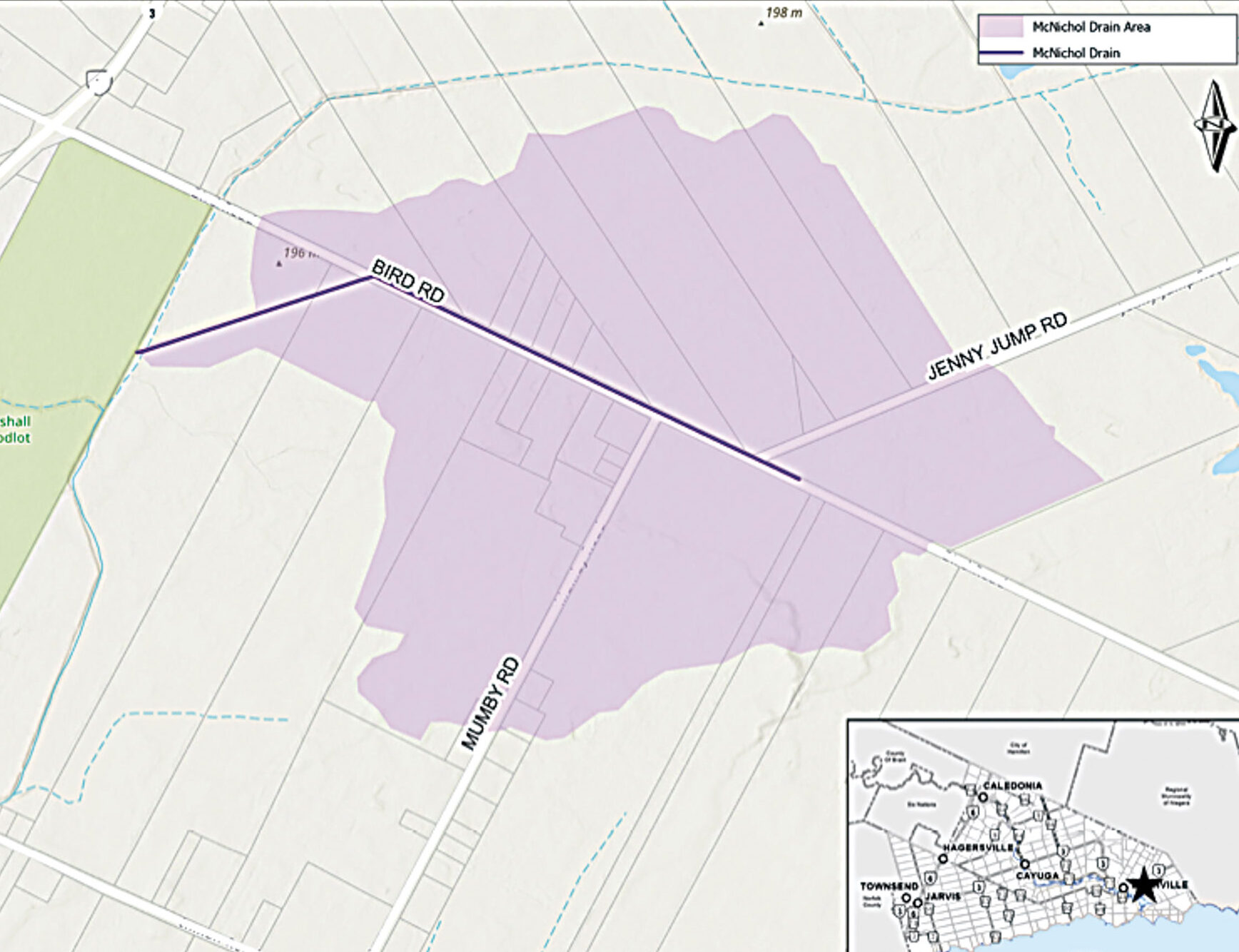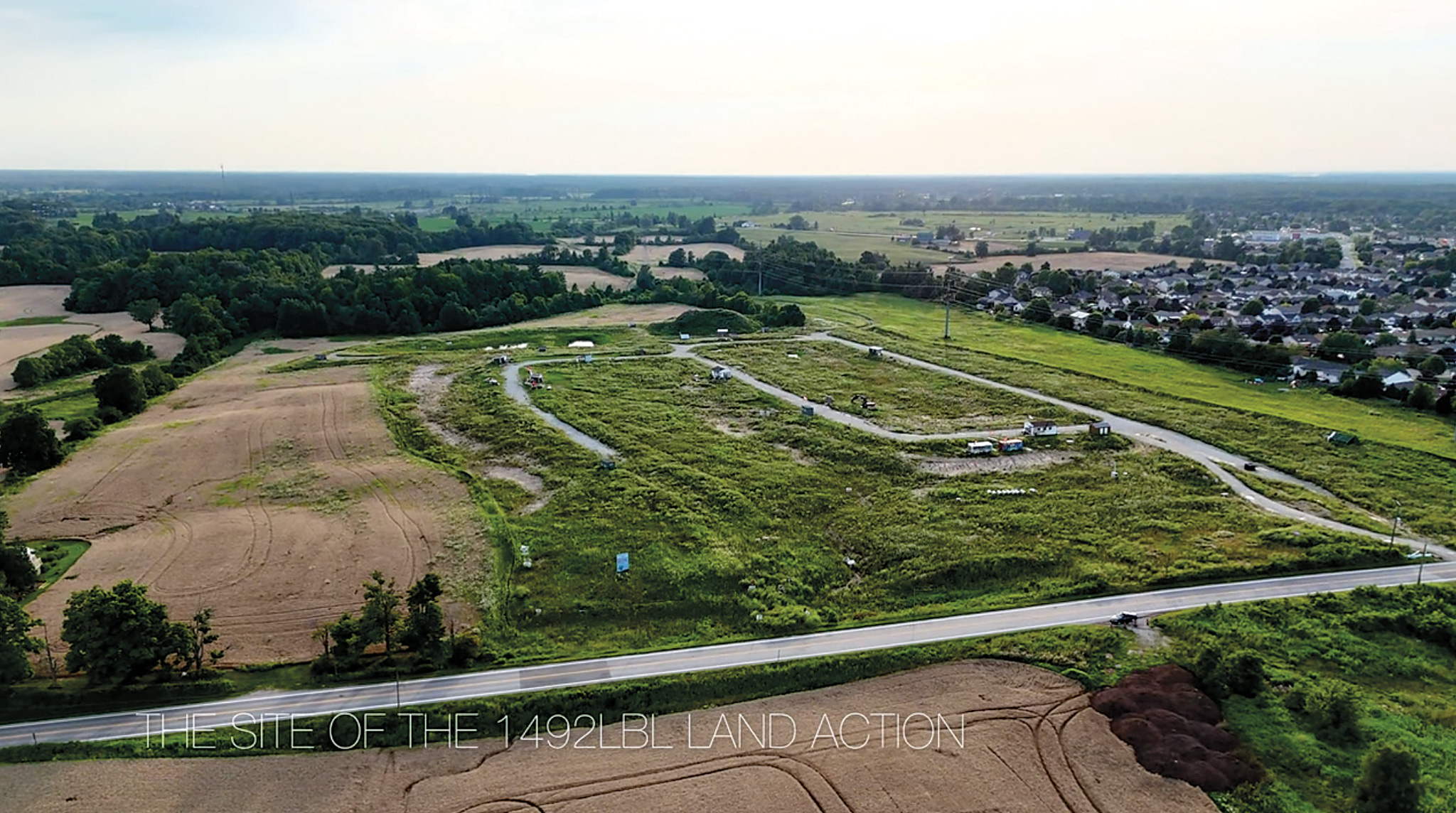HALDIMAND—Required updates to the McNichol Drain, located in the former Moulton Township, were at the centre of a lengthy debate in Haldimand’s Council chambers at a recent meeting, with a significant portion of the cost for those updates falling on landowners accessing the watershed serviced by the drain.

In 2021, Haldimand first commissioned an updated engineer’s report that would detail the scope of work required to keep the drain, originally built in the 1950s and routinely maintained since, running effectively for future use.
The maintenance schedule is dictated by the provincial Drainage Act. Kristopher Franklin, Manager of Haldimand’s Engineering Services, shared some history on the drain, noting how the County ended up footing the bill for maintenance costs during its last servicing due to an issue with an engineer’s report at that time.
“In the early 2010s, the drain was maintained. When we attempted to bill out the cost of the maintenance of the drain, it was determined that the required information that was needed in the engineer’s report wasn’t sufficient to appropriately bill this out to the contributing landowners.”
Kristopher said the updated report was meant to “correct the issue of not having enough information to appropriately manage this municipal drain going forward…. It also allowed us to update the drain, to update needs for the drain going forward that maybe weren’t considered in the original 1950s report.”
The preparation of the new report has included input from the landowners who will be on the hook for payments ranging from $240 up to $17,400, with an average bill of $3,430. According to a staff report, the total cost to landowners is an estimated $137,112.90, while Haldimand is responsible for an estimated $70,771.57 of the total bill.
While each property impacted by the maintenance work was assessed individually, the County noted that approximately $15,200 in land loss allowances is available and will be distributed to landowners with agricultural lands impacted by the maintenance work.
With Council voting to move the report forward to the next step, landowners will have the chance to appear before the Court of Revision to state their concerns and request amendments.
One such person, son of the couple who received the highest assessment at $17,400, spoke to Council, objecting to the engineer’s report and asserting that the drain services only a portion of the family’s land that is forested and not used directly by the family.
“I’m kind of upset. It’s my parents. They’re retired. Imagine getting a $17,000 bill for something we can’t even use? … It’s actually used by ATVs and dirt bikers. We can’t even stop them from using it…. We won’t benefit from this. Why are we the ones that are billed the most for it? … We can’t even clear cut it because of the forest bylaws you guys have. We can’t do nothing with this land; it’s actually mostly swamp. I’m just wondering how Council is going to support somebody like this? That’s my question,” said the concerned resident.
Lorne Franklin, of Robinson Consultants Inc., who was involved in the preparation of the report, replied, “That is one of the items we did have some discussion about. In the engineer’s report there is consideration for forested property that is protected. Typically, in most of the councils we do work for, that comes from a managed forest agreement, so the managed forest tax class; however, it is my understanding that there is a tree protection bylaw that does afford much of the same protection in this county that would come from a managed forest agreement. If that were presented at the Court of Revision, it is something we would be prepared to consider.”
Kristopher noted how assessing land use is the engineer’s responsibility, adding, “If an amendment is made to one property’s assessment, it needs to be added somewhere else. The bottom line stays the same, so either it’s added to one other specific property, or multiple properties, or the ratio is modified for the entire assessment schedule.”
Cost has been a landowner concern from early in the process, first coming to light at an onsite meeting in October 2021, and again at a public meeting in May of this year.
Kristopher is aware of those concerns, but noted, “The intent of municipal drains is … that the drain itself services an individual watershed. Everybody in that individual watershed – lands, roads, utilities – that contribute water to the drain are assessed a cost.”
Currently, County staff are looking at scheduling the maintenance work for 2029. Councillor Rob Shirton asked whether it makes sense to hold off on work given current inflation trends.
Kristopher replied, “It doesn’t need the upgrades today. We’re going to try and maximize the amount of the condition the drain is in now. The upgrades that are required … that’s something the County may move forward with ahead of time, but those costs are assigned to the County directly.”
Some of the required work detailed by the report includes:
- Replacement of select culverts now or during future maintenance due to condition and/or capacity.
- Re-establishment of a smooth and positive slope profile along the entire length of the drain.
- A two-stage profile between the outlet and Bird Rd. for an improved fish habitat.
- Channel widening for improved capacity.
Councillor Patrick O’Neill asked whether the landowner payments could be broken up over time to lessen the impact.
“It’s something that is only billed out when there’s work done on the drain,” replied Kristopher. “Currently, we do our municipal maintenance on a 10-year cycle, so residents would get the assessments only when maintenance is complete…. Typically, it takes 18 months to two years after we do maintenance for a bill to get sent out.”
Mayor Shelley Ann Bentley also expressed an interest in offering landowners a chance to divide their payments: “I’m not on a municipal drain, but I can’t imagine receiving that bill in the mail and being shocked. You do live in that area, you are using that drain, but when you get the bill it’s like, ‘oh my gosh, how am I going to pay for that?’.”
According to Kristopher, once the report is final, the County will apply on behalf of residents to the Ministry of Agriculture and Food and Rural Affairs for a grant to cover one third the assessed costs for agricultural lands included in the report, noting optimistically, “Usually we receive the grant.”
Council approved the adoption of the updated engineer’s report, which will allow landowners the opportunity to plead their case to the Court of Revision, ahead of the finalization of the report.





